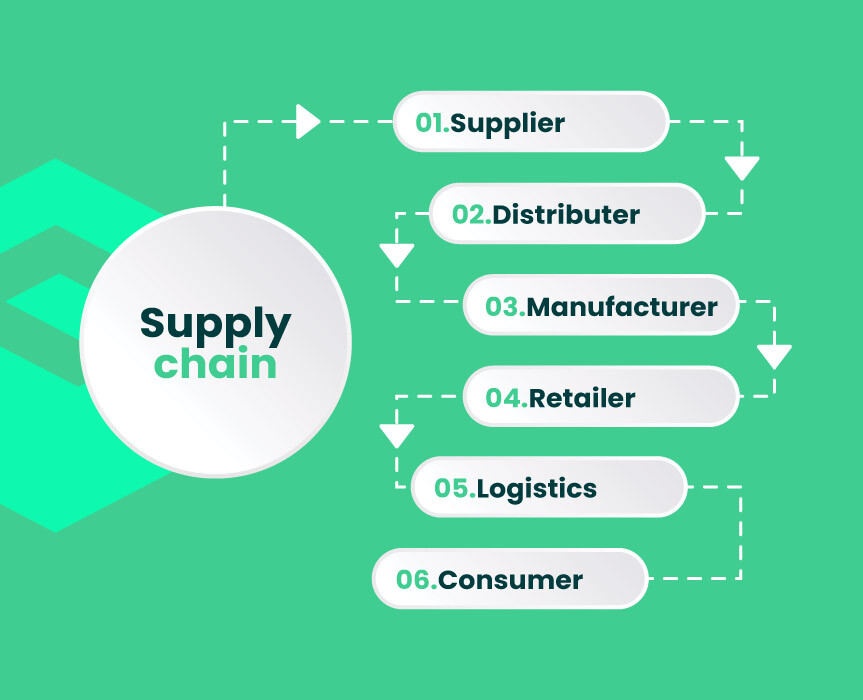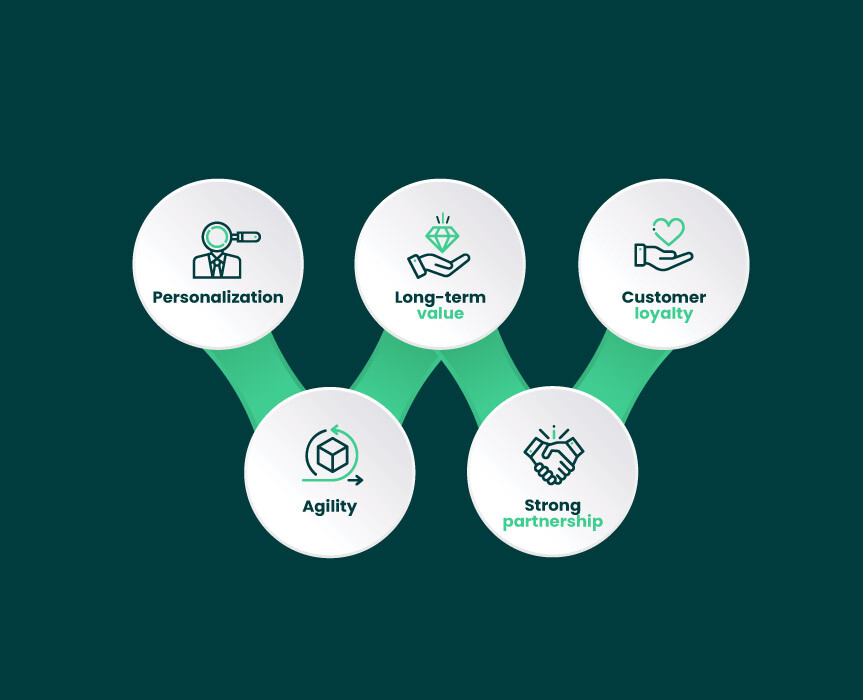Have you heard about the self-preservation instinct? It’s often accompanied by stressful, negative feelings. Such feelings are a sign of danger and help humanity survive in hazardous situations. This is why people remember bad experiences for longer than positive ones. The same works for business. According to Microsoft, poor delivery experience increases the risk of losing more than 50% of their clients.
In the retail world, big figures cannot be ignored. Your retail supply chain should perform well to generate steady income. From the customer demand forecasting to the order fulfillment process — every network stage matters. But how to ensure effective management of your retail supply chain? This is what we’ll talk about.
What Is Supply Chain Management and Why Is It Important?
As a retailer, you know how hard it is to manage back-office operations. If you neglect some gaps or retail challenges, your profit gets lower. Or, what’s worse, you lose your clients and harm your reputation. Don’t want all this to happen? Find tools for effective retail and distribution management. Effective means that you see the consistency of the network elements. You know what aspect to strengthen to get better outcomes in the end.
The thing is, in retail, everything is interconnected. The retail logistics supply chain, for example, affects customer satisfaction. Similarly, the value chain influences your competitiveness. Let’s define these two and check how they shape the importance of purchasing decision in supply chain management.
Retail Supply Chain vs. Retail Value Chain
Retail supply chain and retail value chain do not mean the same. The value chain model describes the process of bringing value to the market. It starts when a company receives raw materials and creates value via production. Then, the final stage of the retail industry value chain takes place. It’s when a client receives a finished product that has a particular function and significance. The more effective your value chain is, the stronger the competitive advantage you get.
Meantime, the retail supply chain describes the steps it takes to supply products to clients. In the supply chain model, we focus not on the final value but on the means of delivering a product. The more effort you put into retail supply chain optimization, the easier it is for you to meet customer demand.
Everything You Need to Know About Supply Chain Management
Both retail supply chain and retail value chain benefit from effective management. Elements of retail supply chain management are shaped by back-office actions and decisions. This, in turn, involves the work of the supply chain team. It includes suppliers, distributors, manufacturers, retailers, transporters, and clients. Merchandising and supply chain management tools help all of them a lot as they get more control over the order fulfillment.

The two main functions of supply chain management are to optimize and maximize. That is, effective management of retail business optimizes your expenses and maximizes quality and speed. Combining these two functions is a challenging task. As National Retail Federation reports, 75% of retail clients expect free delivery if their online order’s cost is lower than $50. Many retailers eagerly rely on the magic of effective management. It allows them to manage multiple delivery options and keep their clients satisfied with service.
How can you understand that your supply chain management works well? Think about this question from the two sides. If your clients are happy with the product quality, quantity, and service, you are moving in the right direction. If you are satisfied with the workflow, cost-efficiency, and profitability of your business — you are also bound to succeed. In case you doubt one of these aspects — check out the section below.
Three Signs It’s Time to Renovate Your Retail Chain Management Strategy
Today, the retail industry is moving towards the omnichannel model. This new e-commerce trend requires retailers to deliver their services impeccably and quickly across channels. The goal of omnichannel commerce is to ensure an excellent customer experience, no matter where and when clients interact with your business. Your retail supply chain network should be updated in real-time and flexible. Here are some signs indicating that your supply chain management needs improvement:
1. Not enough distribution centers
In your retail management effort, focus on two metrics: cost-efficiency and customer satisfaction. On the one hand, retailers should meet client needs and cover online orders for a large area. That is, supply chain leaders should have multiple distribution centers. On the other hand, they should keep their businesses profitable and increase sales. What if you cannot expand your network of distribution centers (or distribution network)? Then optimize the existing one. Renovating your retail chain management strategy with the help of software can be an effective way out.
2. The gap between online and offline
Today, the boundaries between offline and online are blurring. Many consumers like the blend of online and offline experiences. For instance, people prefer to make orders online but save money on delivery opting for in-store pickup. Under such circumstances, ineffective cross-channel coordination may mean lost business opportunities. It poses additional pressure on retailers. It also leads to the need to boost the business’s supply chain management strategy.
3. Capacity issues
Traditional approaches may not work for innovative solutions. Peak-season rises in demand are only one side of the coin. The illusion of “on-shelf availability” of online goods is the other. In the online retail business, there is no sense of the physical quantity of goods. One mistake in supply chain decisions may result in significant financial risks. To eliminate threats, you have to keep your business strategy up-to-date.

If some of these signs reflect your situation, it’s the right time to improve your retail store chain management system. One of the quickest and most affordable ways to do so is to start with supply chain management software. But before rushing into digitizing your business, let’s take a look at its powers and pitfalls.
The Importance of Supply Chain Management Software
The research shows that by 2027, the market share of retail supply chain management software will cross the point of $37 billion.
Why do we see an increasingly high demand for this type of software? Retail supply chain management tools ensure effective information management and product flow. They are a one-time investment that will pay you off throughout your business journey. Moreover, software for retail and logistics management is designed to speed up supplier sourcing. They boost production planning and make transportation planning more efficient.
Let’s look at the traditional management model. The processes like order management, sourcing, and supply are run by different departments. It takes a long time to synchronize the work at every stage. Supply chain issues in one department may cause confusion in other departments. It can affect the quality of the overall management. With supply chain management software, you incorporate all essential functions into one solution. This allows you to ensure end-to-end visibility of your retail supply process.
Software for retail supply chain companies helps businesses a lot. Its functionality covers retail supply chain management key priorities and practices:
- Inventory management. Manage the inventory levels and control the quality and quantity of raw materials and stock.
- Sourcing management. Get the space for interaction with your partners and build strong supplier relationships.
- Warehouse management. Analyze and adjust the storage and labor capacity.
- Customer demand analysis. Do demand planning and analyze demand signals to avoid bottlenecks.
- Logistics management. Optimize transportation costs and expand your online business geographically.
- Risk management. Apply integrated business planning to minimize risks and prevent financial losses.
There are two kinds of retail supply chain automation software. On-premise software is developed to be installed on a local server and used by your team. Software as a service (SaaS) is another type offering a more sophisticated approach. It is a more flexible and practical solution as fixes and updates are added to your system automatically by your software engineering partner. If retailers opt for a SaaS solution, they pay not for the solution itself but for the opportunity to use it.
So what to choose? You can opt for an off-the-shelf solution or build a custom one. The best strategy depends on your business priorities and the scope of functions you would like to have. There are numerous off-the-shelf retail solutions available. Some are free, others require you to pay for a chosen plan. The problem is that both are targeted at a wide range of users, meaning that the aspect of personalization is lost.
Ready-made software does not consider your business values and priorities. The machine, for instance, cannot know that one’s supply partner requires them to use a specific reporting method. It cannot forecast that one has a limited warehouse capacity and wants to balance it with responsive logistics. As a result, users pay for a generic solution that brings little value to their business. Or do not pay, if they choose a free option. In this case, however, they fall into the trap of either limited functionality or an abundance of ads.
Benefits of Custom Supply Chain Management Software
Custom e-commerce software solutions bring many advantages to the retail industry. In fact, all these benefits are interconnected. A positive change in one aspect will also positively affect the changes in another. That is, by investing in a custom retail chain management system, you help your business grow versatilely.
Personalization
There is no one-size-fits-all solution, and the approach of “shipping and forgetting” is no longer relevant. With performant retail management software, retailers get the tools to grow their metrics. They get the opportunity to reallocate products across channels, depending on the real-time updates in the system. As a result, they offer online shoppers a more consistent service. Furthermore, they drive different purchasing behaviors and personalizing experiences.
Future-proof
Retail supply chains in online shopping are all different and have their own weak and strong sides. With a custom software solution, you automate the strong aspects of the supply chain of online shopping and take control of the weak. It allows you to lessen the operation pressure and deeply involve your partners in the work. As a result, you add more long-term value to your business.
Customer loyalty
The custom software is adjusted to the needs of your target audience. End consumer demand, locations, and goods types will be taken into account before building the product. Suppose that you deliver goods to an audience whose location changes regularly. Your buyers do not know for sure where they will be in a few hours. They would appreciate the opportunity to track their orders and reroute them if needed. Another segment of clients may prefer speed over flexibility. This will also be considered before building software.
Agility
Many retailers operate and work using custom software. This enables them to track and control the availability of their channels. Seeing the entire supply chain from the inside, your supply chain executives will be able to plan routes more efficiently. Adjusting your plans and daily decisions in real-time will help you stay agile. At the end of the day, a unified view of consumer supply chain management will save your business from losses and allow for dynamic growth.
Space for a strong partnership
Reputable businesses look for partners who share their work ethics and values. If you invest in custom supply chain management software, you’ll show your dedication. Retail supply management software will allow for transparent cooperation and contract management. All parties involved in the supply process will access and master data, cultivating a strong and reliable partnership.

Challenges in Retail Supply Chain Management for Online Business
But do not hurry up in your decision to renovate the retail management strategy. Consider pitfalls and be rational in your choice. Here are some of the common challenges to be aware of:
Maintaining balance
Do not forget to balance your business goals, client expectations, and competitors’ next steps. Before introducing some changes, analyze how they affect each of the mentioned parties and choose the most optimal strategy.
Leveraging costs
Make a quantitative comparison of the scenarios you are targeting. While choosing the type of software, think about the effects it will make on your supply chain costs. Before aiming at business expansion and offering your clients more, make sure that you are ready to cover more. Our team offers advisory services for digital, and we will gladly help you build the product that will meet your business needs.
Finding reliable partners
Firstly: choose an outsourcing type of cooperation. You will not have to spend money on workspace, equipment, and software to ensure comfortable work conditions. You’ll pay only for the work your outsourced team performs.
Secondly: stay flexible while choosing. Depending on your business needs, you can choose a partner with year-long experience in your particular niche. Namely, Forbytes specializes in eCommerce software development and provides its clients with relevant and up-to-date retail solutions.
Thirdly: apart from the solution itself, you need to get a consistent service of full-cycle development. It involves several stages, from consulting and advisory to maintenance and support. In this way, you secure your investment and get quality assurance.
Final Thought
In this article, we’ve answered the question “What is retail value chain and retail supply chain management?” and discussed supply chain benefits and pitfalls.
In a world where new retail businesses open daily, the stakes are too high. Elements in the supply chains that seem to have little impact on the entire network influence your business tremendously. As a supply chain leader, try to stay flexible and adjust your business to modern clients’ needs. With custom supply management software, you will meet consumer expectations and maintain your competitive advantage.
Let’s get in touch if you aim to renovate your business and keep ahead of the competition.

Our Engineers
Can Help
Are you ready to discover all benefits of running a business in the digital era?

Our Engineers
Can Help
Are you ready to discover all benefits of running a business in the digital era?








